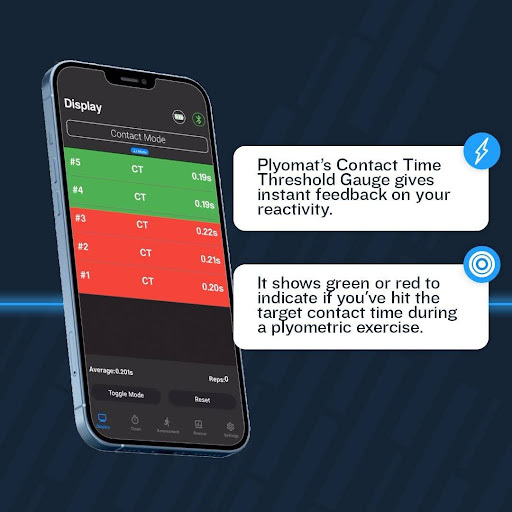Using Ground Contact Time (GCT) as a Modulator for Plyometric Adaptation

Plyometric training is built on the stretch-shortening cycle (SSC) — a rapid transition between eccentric loading and concentric output. But not all plyos are created equal. To truly harness the power of the SSC and ensure your athletes are getting the desired neuromuscular stimulus, one metric stands above the rest:
⏱ Ground Contact Time (GCT)
GCT isn’t just a number — it’s the lens through which we see an athlete’s reactivity, explosiveness, and tissue strategy. Whether you’re chasing reactive strength, rebuilding tissue integrity post-injury, or simply reinforcing efficiency, GCT is the ultimate modulator.
Why GCT Matters
Different GCTs cue different physiological systems:
- < 0.20s: Fast-reactive plyos (true reactive strength)
- 0.20s–0.30s: Transitional; may lose elastic advantage
- > 0.30s: Muscular; more concentric, less SSC
According to Schmidblecher and others in the field, the SSC is most effective under short contact times, often under 0.25 seconds. These ultra-fast contacts favor the elastic components of the musculotendinous system and minimize the energy leak that happens with slower transitions.
Drill Examples by GCT Profile
|
Drill |
Ideal GCT |
Purpose |
|
Depth Drop to Broad Jump |
<.300s |
Max reactive strength |
|
Pogo Jumps |
.150 - .180s |
Fast-twitch, stiffness training |
|
Repeat Hurdle Jumps |
.180 - .250s |
Coordination + reactivity |
|
Approach Jump |
>.300s |
Horiz-Vert. Displacement |
|
Skater/Diagonal Bounds |
.250 - .350s |
Multiplanar SSC |
|
Single-Leg Lateral Hop |
>.300s |
RTP/tissue tolerance |
The goal of the drill determines the GCT, not the other way around. For example, if you’re working with a field sport athlete coming back from an ACL injury, you might intentionally train longer contact times before progressing toward reactive loads.
The Power of Threshold Feedback with Plyomat
The Plyomat app makes this real by allowing coaches to set GCT thresholds inside the mobile app. It gives instant visual feedback using green and red indicators:
- ✅ Green: Within target GCT — stimulus achieved
- 🟥 Red: Missed threshold — rep needs adjustment
This allows athletes to self-correct in real time, and coaches can immediately reinforce or adjust technique, intensity, or cueing — without needing to stop and analyze later.
No clipboards. No guesswork. Just clean, actionable feedback.
Coaching Use-Cases
Real-Time Skill Acquisition
Let’s say you’re coaching hurdle hops. Set the threshold at 0.22s, and your athletes immediately see whether they’re hitting the mark — it turns training into a game of precision.
Teaching the SSC
Athletes often confuse jumping “higher” with jumping “better.” The app helps communicate that in reactive plyos, less time on the ground is the true goal. You’re not just leaving the floor — you’re bouncing off it.
Return to Play Protocols
For rehab progressions, GCT can quantify how far an athlete has come. A post-op jumper may start at 0.40s+ and progressively build back to the elastic zone. The threshold tool gives clear objective checkpoints.
Load Management & Session Modulation
GCT also tells you when fatigue sets in — if contact times drift up over a session, you may be moving from reactive into muscular efforts. Now you have a tool to stop before quality drops.
Final Thoughts
Plyometrics aren’t just about intensity — they’re about intent and timing. Ground Contact Time gives us the ability to prescribe, teach, monitor, and progress plyometric work with clarity and precision.
And with the Plyomat app’s GCT threshold feedback, you have a coachable moment built into every single rep. Whether you’re in the weight room, on the court, or in a rehab setting, this feature helps bridge the gap between data and decision — in real time.
From the Blog
The Plyometric Quadrant: Evidence-Based Zones for...
Plyometric drills can be organized by two levers that drive adaptation:...
What is “Just Jump” Mode?
Understanding the Legacy, Inflation, and Ongoing Use of the Just Jump Mat
In...
Reactive Strength Quadrant Part Two: Programming...
Plyometrics should not live in a world of guesswork. We have the ability to...

.png?width=352&name=unnamed%20(15).png)
